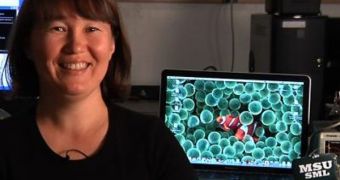Nature is the most potent source of inspiration for just about every aspect of human activity, from painting and music to nanotechnology and, apparently, underwater biomimetic probes. Two experts at the Michigan State University (MSU) have recently taken it upon themselves to create robotic fish, made out of advanced materials, and that could patrol the water as if they were the real deal. This could finally provide scientists with footage and images from within fish schools, or from other locations where even the simple human presence is enough to disrupt the natural activities.
In charge of the investigation are Assistant Professor of Electrical and Computer Engineering Xiaobo Tan, and Kellogg Biological Station Assistant Professor of Zoology Elena Litchman. The Office of Naval Research and the US National Science Foundation (NSF) had funded the two researchers' individual work, even before they decided to team up on the new project. The work also carries with it some important challenges, which the two are confident they will be able to overcome.
“Fish are very efficient. They can perform very efficient locomotion and maneuvering in the water,” Tan reveals. The team envisions creating swarms of robotic fish, perhaps even organized in schools, which would roam the seas or oceans for months on end, completely autonomously and without the need of human intervention. Litchman believes that having such assets at our disposal could significantly further our knowledge of marine ecosystems and water supplies. This would, in turn, help us avoid catastrophic situations, in which mismanagement could endanger our very survival.
“The robotic fish will be providing a consistent level of data that hasn't been possible before. With these patrolling fish we will be able to obtain information at an unprecedentedly high spatial and temporal resolution. Such data are essential for researchers to have a more complete picture of what is happening under the surface as climate change and other outside forces disrupt the freshwater ecosystems. It will bring environmental monitoring to a whole new level,” the zoologist says.
“This project will greatly advance bio-robotic technology. The project is very practical and we are designing the fish to be inexpensive so they can be used in various applications like sampling lakes, monitoring aquafarms and safeguarding water reservoirs,” Tan adds.
“As air temperature increases, the lakes and reservoirs also heat up. Increasing water temperature creates strong stratification within the various layers of the water and this may lead to increased growth of harmful algae. Some of these algal blooms create poor conditions for fish and exude toxins that also endanger people,” Litchman explains. The existing robotic-fish prototype currently swimming in Tan's laboratory is about nine inches long, and it is used for testing the various systems that will go inside its successors, once a definitive design has been decided on.

 14 DAY TRIAL //
14 DAY TRIAL //